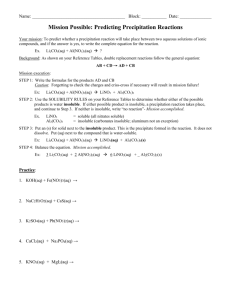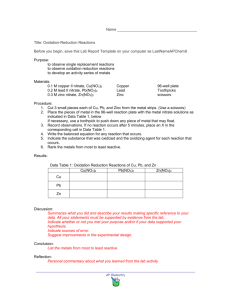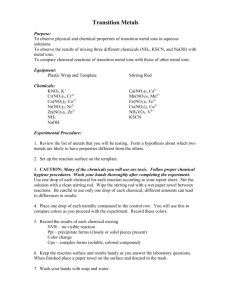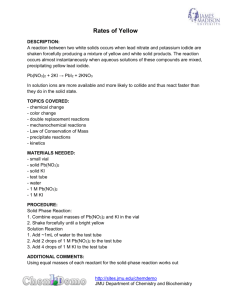Balancing Chemical Equations
advertisement
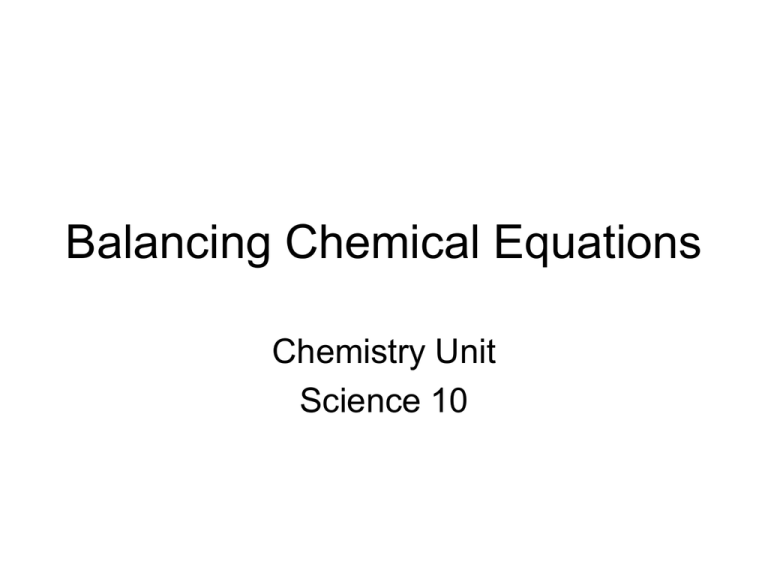
Balancing Chemical Equations Chemistry Unit Science 10 What is a chemical equation? • When a chemical reaction occurs, it can be described by an equation. • This shows the chemicals that react (called the reactants) on the left-hand side, and the chemicals that they produce (called the products) on the right-hand side. • The chemicals can be represented by their names or by their chemical symbols. What is a chemical equation? • For example: • Aluminium + Oxygen Reactants Aluminium Oxide Product • Numbers found in front of the elements are called coefficients. ex: 2Aluminium To balance a chemical equation Step 1: Write the skeleton equation (aka, no numbers) • Be sure you have the correct formulas for all the compounds. • Watch especially for polyatomics Ex: Al + NO3 Al2(NO3)3 To balance a chemical equation Step 2: Balance the elements or polyatomic ions that appear just once on each side first. Ex: Al + NO3 2Al + 3(NO3) Al2(NO3)3 Al2(NO3)3 To balance a chemical equation Step 3: Check for any terms you haven’t looked at and balance them so the total on the reactants side = the total on the products side. Ex: Al + NO3 2Al + 3NO3 6Al + __NO3 Al2(NO3)3 Al2(NO3)3 __Al2(NO3)3 To balance a chemical equation Step 4: Double check the equation • A table can be very helpful Ex: 2Al + 3NO3 Al = 2 NO3 = 3 Al2(NO3)3 Al = 2 NO3 = 3 Example - Photosynthesis • Word Equation: water + carbon dioxide + sun energy produces carbohydrate + oxygen • Skeleton Equation: H2O + CO2 + sun energy C6H12O6 + O2 Example - Photosynthesis H2O + CO2 + sun energy C6H12O6 + O2 • H appears only once on each side. Choose a coefficient 6 for H2O (to put 12 hydrogen on each side) (6x2 = 12) 6H2O + __CO2 + energy __C6H12O6 + __O2 • C appears only once on each side. Choose a coefficient 6 for CO2 (6x1 = 6) 6H2O + 6CO2 + energy __C6H12O6 + __O2 Example - Photosynthesis 6H2O + 6CO2 + sun energy C6H12O6 + O2 • Oxygen appears more than once on both sides. Count the total on each side and make the adjustment as needed. 6O + 12O = 18O 6O + 6x2O = 18O 6H2O + 6CO2 + energy C6H12O6 + 6O2 H = 12 H = 12 C=6 C=6 O = 18 O = 18 Diatomic Elements Diatomic means that they exist as X2 instead of just X in the natural environment. There are 7 diatomic elements: • • • • • • • Hydrogen (H2) Nitrogen (N2) Oxygen (O2) Fluorine (F2) Chlorine (Cl2) Iodine (I2) Bromine (Br2) Types of Reactions • Reactions can be either Exothermic or Endothermic. • Exothermic reactions: Reactions where energy is… released. • Endothermic reactions: Reactions where energy is… absorbed Types of Reactions • In Photosynthesis, energy is required. It is on the reactant side of the equation. Therefore it is… Endothermic • In Cellular Respiration, energy is given off. It is on the product side of the equation. Therefore it is… Exothermic *Even if a small amount of energy is needed to start the reaction (like a match), if there is energy generated by the reaction itself (like an explosion), it is exothermic Types of Reactions: Synthesis • When a reaction has two or more reactants that synthesize to form a new product. X + Y XY ex: water is synthesised from hydrogen and oxygen gas: 2H2(g) + O2(g) 2H2O(l) + thermal energy Types of Reactions: Decomposition • A compound decays into two or more simpler compounds or elements. XY X + Y ex: water + energy decays into hydrogen and oxygen gas (boiling water): 2H2O(l) + thermal energy 2H2(g) + O2(g) Types of Reactions: Single Displacement • One element takes the place of (displaces) another element in a compound A + BX B + AX or AX+ Y AY + X ex: 2Mg(s) + 2 HCl(aq) 2MgCl(aq) + H2(g) 2AgNO3(aq) + Cu(s) Cu(NO3)2(aq) + 2Ag(s) One element takes the place of another Types of Reactions: Single Displacement • This is like someone cutting in on a couple dancing. • Before the ‘cut-in’ there are two people dancing and one single. • After the ‘cut-in’ there are still two people dancing but one has changed and there is a different single. Types of Reactions: Single Displacement • Predict the products of the following reaction: • cobalt + aluminum chloride • The metal element (cobalt) replaces the positive ion (aluminium) in the compound. • cobalt + aluminum chloride aluminum + cobalt(II) chloride Types of Reactions: Single Displacement • How did we know the charge on cobalt was +2 since it is multi-valent (has more than 1 charge)? • When predicting single displacement reaction products, we choose the most common charge for the metal ion. • The most common charge is listed first on your periodic table of ions. Types of Reactions: Double Displacement • The positive ions of two different compounds change (displace) places, forming 2 new compounds. WX + YZ WZ + YX ex: NaOH(aq) + HCl(aq) NaCl(aq) + HOH(l) Types of Reactions: Double Displacement • This is like a dance where two couples are dancing and they exchange partners. • Before the exchange everybody is dancing. • After the exchange, everybody is still dancing but with a different partner. Types of Reactions: Double Displacement • Predict the products of the following reaction: – cobalt(II) nitrate + aluminum chloride • The metal ions (cobalt(II) and aluminium) switch places. cobalt(II) nitrate + aluminum chloride cobalt(II) chloride + aluminum nitrate • Notice that the charge on each metal ion remains the same on both sides of the reaction arrow. • Remember to balance the reaction after you have predicted the products – 3Co(NO3)2 + 2AlCl3 3CoCl2 + 2Al(NO3)3 Types of Reactions: Combustion • The reaction of a substance with a diatomic oxygen molecule is said to be a combustion reaction. • AB + O2 AO + BO • Combustion reactions are almost always exothermic (they give off heat). • For example when wood burns, it must do so in the presence of O2 and a lot of heat is produced: Types of Reactions: Combustion • Wood as well as many common items that combust are organic (i.e., they are made up of carbon, hydrogen and oxygen). • Organic chemistry is chemistry involving these 3 elements and has a lot to do with biological make up. • When organic molecules combust the reaction products are carbon dioxide and water (as well as heat). Which is the Which of Which one? ___ Pb(NO ___ PbO ++ 4___ O2 Decomposition 2 Pb(NO 2 PbO NONO 3)23) 2 2 + 21+O___ 2 3 Ca + 2 SO Ca3Ca (SO ___ Ca + ___ SO33 1___ 3)2 3)2 3(SO Synthesis 1 Ca +2H Ca(OH) ___ Ca + ___ H22O O 1___ Ca(OH) H2 2 + 21+H___ 2 Single Displacement 2 CrCl +3H Cr2Cr (SO +)36+HCl ___ CrCl H22SO SO44 1___ ___ HCl 4 )3 4 3 +3 ___ 2(SO Double Displacement 1 Fe(NO + 3 NH Fe(OH) ___ Fe(NO NH44OH OH 1___ Fe(OH) ___ NH 3 ___ 3 + 33+NH 4NO 3 4NO3 Double 3)33)+ Displacement Single ___ Al ++ ___ PO44 1___ AlPO + ___ K 1 Al 1 KK33PO AlPO + 3 K 4 4 Displacement ___ Fe ++ ___ O22 2___ 4 Fe 3O Fe2Fe O32O3 Combustion


